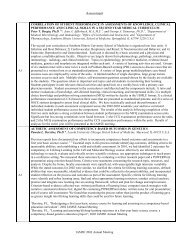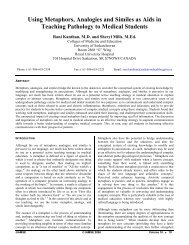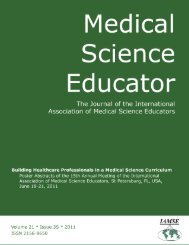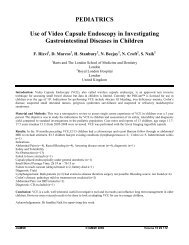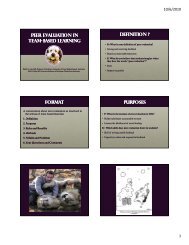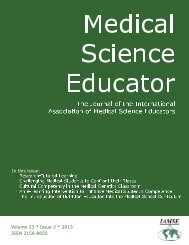Click here to view complete journal in pdf-format - IAMSE
Click here to view complete journal in pdf-format - IAMSE
Click here to view complete journal in pdf-format - IAMSE
You also want an ePaper? Increase the reach of your titles
YUMPU automatically turns print PDFs into web optimized ePapers that Google loves.
aga<strong>in</strong>st <strong>in</strong>tracellular and extracellular microbes. A<br />
diagram for extracellular microbes was presented at<br />
the 2011 <strong>IAMSE</strong> Meet<strong>in</strong>g and published this year <strong>in</strong><br />
MedEdPORTAL. This approach could be further<br />
extended <strong>to</strong> facilitate student’s knowledge of<br />
immune defense mechanisms aga<strong>in</strong>st specific<br />
microbes (e.g., helm<strong>in</strong>ths/Type I Hypersensitivity).<br />
Instructional Methods Abstract ID: 189 Award<br />
Nom<strong>in</strong>ee<br />
BIRTH OF A MEDICAL SCHOOL - THE<br />
SALINA EXPERIENCE<br />
Michael Rob<strong>in</strong>son 1 , William Cathcart-Rake 1 , Laura<br />
Easterday 1 and Heidi Chumley 2 , 1 University of<br />
Kansas School of Medic<strong>in</strong>e, Sal<strong>in</strong>a KS, 67401,<br />
U.S.A., 2 University of Kansas Medical Center,<br />
Kansas City, KS, USA<br />
PURPOSE<br />
Many rural areas of the US have communities<br />
underserved by physicians. A widely accepted<br />
explanation for this deficiency is that medical<br />
schools are frequently situated <strong>in</strong> the more<br />
populated cities <strong>in</strong> a state, result<strong>in</strong>g <strong>in</strong> newly<br />
qualified physicians opt<strong>in</strong>g <strong>to</strong> practice <strong>in</strong> similar<br />
urban areas.<br />
METHODS<br />
To counteract this trend, Kansas University School<br />
of Medic<strong>in</strong>e (KUSM) postulated that open<strong>in</strong>g a<br />
medical school <strong>in</strong> Sal<strong>in</strong>a, KS, a community of<br />
50,000, would attract students eager <strong>to</strong> tra<strong>in</strong> and<br />
subsequently work <strong>in</strong> rural parts of the state. These<br />
students would receive basic science lectures from<br />
the ma<strong>in</strong> campus <strong>in</strong> Kansas City, via live <strong>in</strong>teractive<br />
television. However, all labs, small group sessions,<br />
and cl<strong>in</strong>ical tra<strong>in</strong><strong>in</strong>g would be taught <strong>in</strong> Sal<strong>in</strong>a by a<br />
m<strong>in</strong>imal faculty supplemented by local physicians.<br />
Admission requirements, curriculum and<br />
performance standards for these students would be<br />
identical <strong>to</strong> those at the ma<strong>in</strong> campus.<br />
RESULTS<br />
In August 2011, KUSM-Sal<strong>in</strong>a accepted eight first<br />
year medical students, becom<strong>in</strong>g the smallest<br />
medical school campus <strong>in</strong> the US. Lectures from the<br />
ma<strong>in</strong> campus have been well received by the<br />
students and all local classes have excellent student<br />
satisfaction rat<strong>in</strong>gs. Currently, all students are<br />
successful academically, have <strong>in</strong>tegrated well <strong>in</strong><br />
Sal<strong>in</strong>a, and cont<strong>in</strong>ue <strong>to</strong> express a desire <strong>to</strong> practice<br />
medic<strong>in</strong>e <strong>in</strong> small communities <strong>in</strong> Kansas<br />
CONCLUSIONS<br />
Results <strong>to</strong> date would <strong>in</strong>dicate that medical schools<br />
may be sited successfully <strong>in</strong> smaller rural<br />
communities <strong>in</strong> the US when work<strong>in</strong>g <strong>in</strong><br />
conjunction with a larger urban campus. Evidence<br />
would also suggest that tra<strong>in</strong><strong>in</strong>g medical students <strong>in</strong><br />
rural areas will result <strong>in</strong> graduat<strong>in</strong>g physicians who<br />
will be fully assimilated <strong>in</strong><strong>to</strong> rural communities and<br />
thus be more likely <strong>to</strong> stay and practice w<strong>here</strong> they<br />
tra<strong>in</strong>ed. Additionally, this <strong>in</strong>novative model for a<br />
medical school campus has proven <strong>to</strong> be very cost<br />
efficient <strong>in</strong> a time of limited resources.<br />
Instructional Methods Abstract ID: 191<br />
TO ASSESS THE KNOWLEDGE OF<br />
ANATOMY AND PERCEPTION OF<br />
ANATOMY TEACHING USING HUMAN<br />
PLASTINATE MODELS FOR FINAL YEAR<br />
UNDERGRADUATE MEDICAL STUDENTS<br />
AT WARWICK MEDICAL SCHOOL.<br />
Mr Rajiv Subbu MbChb MRCS BSci(Hons) Mr<br />
Rajpal Nandra Ms Hannah Smith Ms Hannah<br />
Dixon Professor Abrahams MBBS FRCS(ED) FRCR<br />
DO(Hon) FHEA. Prof. of Cl<strong>in</strong>ical Ana<strong>to</strong>my Brian<br />
Burnett, UK<br />
PURPOSE<br />
F<strong>in</strong>al year students report a lack of basic ana<strong>to</strong>my<br />
knowledge and feel under prepared for f<strong>in</strong>al year<br />
exam<strong>in</strong>ations. Ana<strong>to</strong>my teach<strong>in</strong>g has evolved from<br />
the traditional cadaveric dissect<strong>in</strong>g curriculum at<br />
many undergraduate <strong>in</strong>stitutions. A greater reliance<br />
is placed on self-directed learn<strong>in</strong>g us<strong>in</strong>g a range of<br />
learn<strong>in</strong>g <strong>to</strong>ols from conventional books, e- modules<br />
and prosection specimens. We designed a study<br />
us<strong>in</strong>g human plast<strong>in</strong>ate models <strong>to</strong> teach medical<br />
students and assess changes <strong>in</strong> undergraduate's<br />
knowledge and approach <strong>to</strong> learn<strong>in</strong>g and<br />
understand<strong>in</strong>g ana<strong>to</strong>my.<br />
METHODS<br />
The eight-week ana<strong>to</strong>my course was designed for<br />
F<strong>in</strong>al year medical students at Warwick Medical<br />
School and hosted by the West Midlands Surgical<br />
Tra<strong>in</strong><strong>in</strong>g Centre who have a vast array of human<br />
plast<strong>in</strong>ate ana<strong>to</strong>my models. (Images available for<br />
conference on poster) The course objectives<br />
outl<strong>in</strong>ed parallel the Medical School’s Curriculum.<br />
The broad <strong>to</strong>pics <strong>in</strong>cluded ana<strong>to</strong>my of the abdomen,<br />
thorax, gro<strong>in</strong> and pelvis, head and neck, upper limb,<br />
lower limb and procedural ana<strong>to</strong>my. Each week a<br />
broad <strong>to</strong>pic was taught, with small group sessions<br />
led by two <strong>in</strong>struc<strong>to</strong>rs. Of the five stations one was<br />
designated <strong>to</strong> cl<strong>in</strong>ical scenarios <strong>to</strong> promote<br />
functional ana<strong>to</strong>my utilised frequently as a qualified<br />
doc<strong>to</strong>r. F<strong>in</strong>al year candidates were allocated <strong>to</strong> a<br />
teach<strong>in</strong>g programme held three times a year, the<br />
first twenty email responses were designated <strong>to</strong> each<br />
course for small group <strong>in</strong>teractive teach<strong>in</strong>g sessions.<br />
Medical Science Educa<strong>to</strong>r © <strong>IAMSE</strong> 2012 Volume 22(4S) 312



